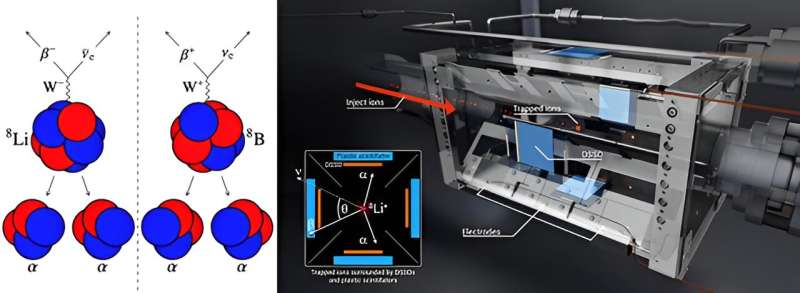Left: The “mirror” nuclei lithium-8 and boron-8 undergo beta decay and then split into two alpha particles. Right: An ion trap device is used to suspend radioactive ions in a vacuum at Argonne National Laboratory’s ATLAS accelerator. Image credit: A. Gallant (left) and Lawrence Livermore National Laboratory (right)
The Standard Model of particle physics is scientists’ best understanding of the forces that describe how subatomic particles interact. The Standard Model contains four forces: the strong nuclear force, the weak nuclear force, the electromagnetic force, and gravity. All four forces govern the way our universe works. However, the weak nuclear force is extremely difficult to study because it is obscured by the larger influence of the strong nuclear force and the electromagnetic force.
Through detailed studies of the beta decay of the “mirror” nuclei lithium-8 and boron-8, scientists have gained a new understanding of the weak nuclear force. Mirror nuclei are atoms with the opposite number of protons and neutrons. For example, lithium-8 has 3 protons and 5 neutrons, while boron-8 has 5 protons and 3 neutrons.
Scientists have made a new, more sensitive measurement of beta decay properties to look for theoretical features of the weak nuclear force that are not currently included in the Standard Model. The weak nuclear force drives the nuclear beta decay process. In beta decay, a proton or neutron in the nucleus emits a beta particle (an electron or its antiparticle, the positron) and a neutrino.
The beta decay properties of the radioactive mirror nuclei lithium-8 and boron-8 are exactly as predicted by the Standard Model. This work combines state-of-the-art experimental and theoretical methods and paves the way for future advances in the study of the weak nuclear force.
A team of nuclear scientists from Lawrence Livermore National Laboratory, Argonne National Laboratory, and Louisiana State University precisely measured the beta decay properties of the “mirror” nuclei lithium-8 and boron-8 to better understand the weak nuclear force . Mirror nuclei have the same total number of protons and neutrons, but the opposite number of each particle.Research results published in journal Physical Review Letters.
Mirror nuclei provide the opportunity to study the weak nuclear force with greater sensitivity. The predicted features of many of the much sought after new effects would be to produce opposite contributions in two different nuclei. This will allow scientists to compare results for lithium-8 and boron-8 to isolate the contribution of each nucleus to the decay.
By studying the two nuclei using a beta-decay Paul trap, a device that holds a cloud of ions in a vacuum, the researchers determined the energy and direction of the emitted beta particle and two alpha particles with high precision. This method allowed the researchers to reconstruct the complete decay characteristics, including the contribution of unseen neutrinos.
The Standard Model (SM) predicts the distribution of emission angles for beta particles and neutrinos, and any observed differences would reveal new aspects of the weak nuclear force.
The team is looking for differences of less than 1%, which requires a thorough understanding of the equipment and detection systems, coupled with a newly developed first-principles approach, using “symmetry-adapted coreless shell model theory” to explain the many complex nuclear environments. small impact. The results are the most accurate of their kind and more credibly confirm SM predictions.
More information:
AT Gallant et al. “Angular dependence in decay” 8B: The first tensor current limit of the mirror check, Physical Review Letters (2023). DOI: 10.1103/PhysRevLett.130.192502
Provided by the U.S. Department of Energy
citation: Beta decay measurements in mirror nuclei identify weak nuclear force (2024, April 22), Retrieved April 22, 2024, from https://phys.org/news/2024-04-beta-decay-mirror -nuclei-pin.html
This document is protected by copyright. No part may be reproduced without written permission except in the interests of fair dealing for private study or research purposes. Content is for reference only.
#Beta #decay #measurements #mirrorimage #nuclei #identify #weak #nuclear #force
Image Source : phys.org
